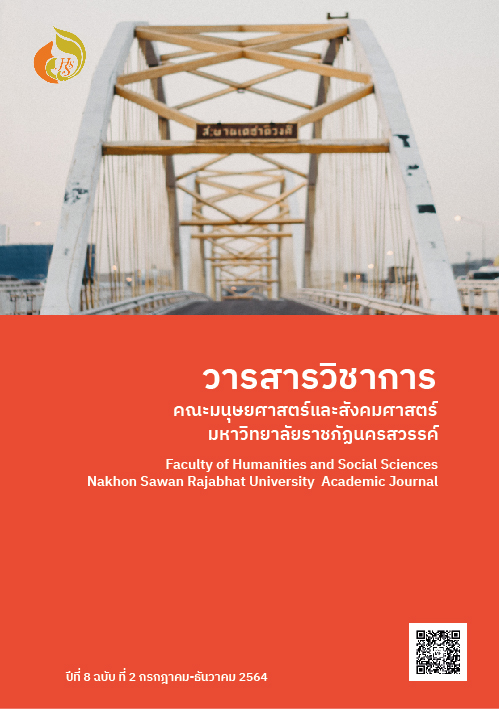A Competitive advantage in the Business of Exporting the Thai Food Industry to Asian Economic Community
Main Article Content
Abstract
The objectives of this research are 1) to explore the factors of entrepreneurship, Innovation factor, Output capability factor which creates a competitive advantage of the Thai food industry export business 2) to analyze the relationship model of the composition factor, such as entrepreneurship factor, innovation factor, output capability factor, and output capability factor which creates a competitive advantage in the Thai food industry export business which creates a competitive advantage in the Thai food industry export business 3) to analyze the influence of the entrepreneurial factor, innovation factor output capability factor which creates a competitive advantage in the Thai food industry export business 4) to be a way to find the export capabilities that create a competitive advantage in Thai food industry exports to the ASEAN Economic community. Using quantitative research, qualified 5 rating scale questionnaire was a research tool, with the Content Conformity Index (IOC) of 0.67-1 and the confidence of Cronbark's alpha coefficient of 0.96. A sample group are 400 executives of Thai food industry export companies by simple randomize sampling to draw lots. The statistics used in the quantitative research were mean, standard deviation, Statistical analysis of structural equation modeling (SEM) by using a computer program. Data analysis results 1) Entrepreneurship survey results, found that: the entrepreneurship of the export business was at a high level by overall, innovation factor, and export capacity factors were at moderate level. Competitive advantage in Thai food industry by overall was at a moderate level too. 2) The analysis of the relationship model, composition, variables and factors of these four aspects showed that the measurement model was consistent with the empirical data. There is enough statistical value that can be analyzed. 3) Results of analysis of influence on factors which creates a competitive advantage in the Thai food industry export business (Results of hypothesis testing) found that all of these assumptions were accepted. 4). The results of the search for export ability that create a competitive advantage in Thai food industry exports to the ASEAN economic community, found that the model was consistent with the structure by passing the hypothesis test which has been statistically confirmed that It is a factor that influences the competitive advantage in the business of exporting the Thai food industry to the ASEAN economic community. With the observable variable with the highest element weight value to enable those who will apply such factors as factors of entrepreneurship, including proactive management. Innovation factors include product innovation. The variables passed on the export capability factor to competitiveness of the export, namely skills and expertise. The resulting variable was the export advantage factor with the highest element weight value was export growth.
Article Details

This work is licensed under a Creative Commons Attribution-NonCommercial-NoDerivatives 4.0 International License.
References
กรุงเทพธุรกิจ (2564). DITP ชูศักยภาพผู้ส่งออกสินค้าอาหารไทยผ่านการรับรองจาก 4 หน่วยงานรัฐ.สืบค้นจาก (https://www.bangkokbiznews.com/pr/detail/78231 .
ฐิติวดี ชัยวัฒน์. (2560).การบริหารความเสี่ยงภัย และการประกันภัยใน ศตวรรษที่ 21. พิมพ์ครั้งที่ 3.
กรุงเทพฯ. โรงพิมพ์แห่งจุฬาลงกรณ์มหาวิทยาลัย.
เนตรนภา ไวทย์เลิศศักย์,( มปป.)ปัญหาอุปสรรคในการส่งออกสินค้าอาหารแปรรูปไทย
ไปตลาดอาเซียน.กรุงเทพฯ, คณะพาณิชยศาสตร์คลังบัญชี มหาวิทยาลัยธรรมศาสตร์
สุภมาส อังศุโชติ และ คณะ (2552). โปรแกรม SPSS และตามด้วยการวิเคราะห์โมเดลมินิด้วย
โปรแกรม LISREL .คณะพัฒนาสังคมและสิ่งแวดล้อม สถาบันบัณฑิตพัฒนบริหารศาสตร์
BLT. (2564). อุตสาหกรรมอาหารไทยครึ่งแรกปี 63 ผลิตลดลงร้อยละ 8.6 พบส่งออกเตะ 5 แสนล้านบาท
สืบค้นจาก (https://www.bltbangkok.com/news/27556/ )
Aydin,K. & Thandiwe, M.(2016). Impact of marketing effectiveness and
capabilities and export market orientation on export performance: Evidence from Turkey. European Business Review.28(5), 532-559.
Carlos M.P.Sousa & Jorge Lengler.(2011).Examining the Determinants of Interfunctional
Coordination and Export Performance: an Investigation of Brazillian Export.
Internatiovnal Marketing Review., 21,189-206.
Day,G.S. and Wensley, R. (1988). Assessing advantage: A Framework for diagnosing competitive superiority. Journal of Marketing.16(1),1-20
Dess, G. G., Lumpkin, G.T., & Covin, J.G. (1997). Entrepreneurial Strategy marketing and
performance tests of contingency and configurational models, Strategic Management Journal,18(3), 677-695.
Godwin Mwesigye Ahimbisibwe. Stefen Kurutaro Nkundabanyanga, Gideon Nkurunziza
& David Nyamuyonjo. (2016). Knowledge absorptive capacity: do all its dimensions matter for export performance of SMEs?. World Journal of Entrepreneurship Management and Sustainable Development.12(2): 139-160.influenced by network externality. from https://www.google.com/search?q-10/2/2020
Jraisat, L.; Gotsi.M. and Bourlakis, M.(2014). Drivers of information Sharing and
export performance in the Jordanian agri-food export supply chain. International Marketing Review. 30(4), 323-356.
Lee, J.S. & Hsieh C. J. (2010). A research in relating entrepreneurship, Marketing capability,
innovative capability and sustained competitive advantage. Journal of Business and Economics Research, 8(9),109-120.
Lien et.al., 2011.; Lien,B.,Wim,J., Marion,D.,and Tinne,L.(2011). A study of the relationships
Between generation, market orientation, and innovation in family firms. Family Business Review. 24(3), 252-272.
Pham,T.,Monkhouse,L.and Barnes,B.(2017).The influence of relational capability and marketing
capabilities on the export performance of emerging market firms. International Marketing Review. 34(5),606-628.
.Urabe, K., Child, J. & Kagano,T.(1988). Innovation and management International comparison.
The Concept of Fit in Contingency Theory, Berlin: Walter de Gruyter and Co.


